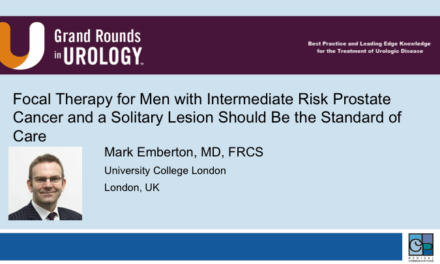Dr. Alan W. Partin spoke at the 24th International Prostate Cancer Update on Thursday, February 20, 2014 on “A Review of the 2013 AUA Guidelines on Early Detection of PCa.” In his presentation, Dr. Partin discusses an update on the AUA guidelines for early detection of and to reduce the mortality of prostate cancer.
Presentation:
Keywords: AUA, detection, guidelines, PSA, testing, evidence, prostate, screening
How to cite: Partin, Alan W. “A Review of the 2013 AUA Guidelines on Early Detection of PCa.” January 9, 2015. Accessed Jan 2025. https://dev.grandroundsinurology.com/prostate-cancer-alan-w-partin-early-detection-pca/.
Transcript
A Review of the 2013 AUA Guidelines on Early Detection of PCa
I’m going to give you an update on the AUA guidelines for early detection of prostate cancer. And before I start, make sure you have your iPad╒s fired up. We are going to go through four of the ARS questions just to see where everybody is with respect to these guidelines. So if you could pull up my first question, Mike.
So these are going to be broken down by age groups. And AUA screening guidelines for a 42-year old man presently say no testing, just check their PSA B, PSA and a DRE, or just go ahead and do an MRI. So if everyone would vote on that one. Today this talk I’m going to give today is rather heavy on information. I borrowed it from Beau Carter who presented this at the AUA. Good, everyone got that one right. They recommend for people under age 50 no testing at all.
The second question, so if you are a 74-year old, the new AUA guidelines say, A, no testing; B, a PSA only; C, PSA and DRE; or just to straight to an MRI. So you may want to request this talk because there are a lot of slides in here that I am just simply not going to go over because they are quite verbose and pedantic for Carter╒s presentation. Actually the correct answer is number one, they recommend no testing. So number three, now we get to an age group where we are seeing most of our patients. He’s aged 59, no testing, a PSA only; a PSA and DRE after discussion of risk and benefit; or just go ahead and get a biopsy on the patient.
And the last question after this, I will be most curious to see everyone╒s answer. Very good. Just essentially everybody got that one right. And the final question says I ╥blank╙ with the new screening guidelines from the AUA; I totally agree; I agree somewhat; I don’t really pay attention to the new screening guidelines; or I disagree. Interesting, there’s quite a spread across there. “Somewhat agree” was the highest at 42%, so I will put my talk on now.
So I’m going to go over the AUA guidelines and, again, there are a lot of slides here. Request them if you want them. I’m just going to cover the highlights so we can see those answers to those questions. I am going to mention the Melbourne Consensus Conference that was held in 2013, and look at how their recommendations were not necessary even called guidelines when they came out. And, lastly, the European guidelines and how they differ from those that were put out by the AUA.
So the first disclosure is don╒t shoot the messenger. I did not make these guidelines. They were put together by this panel from the AUA. It was led by Beau Carter, and that picture down there on the bottom is what Beau looked like when he started working on the guidelines and what he looks like now. So you can see that he took a lot of hit from putting this together and presenting it at the AUA. So we had guidelines that were put out in 2009 in the Best Practice statement. And it was basically an evaluation of PSA for detection, risk stratification, and the management of prostate cancer. There was no systematic literature review for those guidelines at that time. The level of evidence for the decisions was not evaluated.
And the recommendations were primarily based on clinical experience and expert opinion of a panel of experts who were brought together to come up with the recommendations. So why do we need a new guideline? Evidence based evaluation of prostate cancer detection, we were previously looking for the guidelines of how we could detect cancer, and now we are looking for an evaluation to reduce the mortality of cancer. So this is where you are going to see the major differences in what changed in the guidelines. And the statements were now based on evidence rather than just opinion and clinical experience.
So the methodology, they got together and looked at papers in the literature, the 1995 to 2013, looking at all of these important points. You start seeing words like shared decision making coming in. They found 324 eligible studies and looked at the incidence, mortality, and quality of life now, diagnostic accuracy, and harms from testing. You are going to see a lot of the new guidelines mentioning whether or not what we are doing is harming people more than helping them. So then the evidence was based upon on whether they were randomized controlled trials to evaluate them. Some of the data was modeled and some of it was taken primarily from a large population data studies.
Levels of evidence were applied to every one of the statements. A level A, which none of them met, was a well-conducted, randomized, controlled trial; level C was basically an observation study that was inconsistent and difficult to interpret. Most of the levels of evidence that were utilized to come up with the guidelines were either B╒s or C╒s. So the guidelines panel got together and looked at the harm/benefit ratio. They broke the groups of patients down to those less than 40, between 40 and 54, 55 to 69, and men over the age of 70.
So the guidelines statement one for men less than 40, and that was our first question this morning, they recommend against PSA-based screening for all men under age 40. And here it is a recommendation and the level was grade C. If you remember that wasn╒t a very high recommendation. And you can read this again if you want to get the slides. I’m not going to read all of these to you, but there is a very low prevalence of cancer in this group and it didn’t recommend looking for it because we were harming people more than helping them.
For those between 40 and 54, screening is not routinely recommended for these men. And, again, these are all men at average risk. When you do have high risk patients, they are recommending that you consider a? I have highlighted all the words, individualized, personal preference, informed discussion regarding uncertainty, benefit, harms, etc. And it was hard to get out of the panel exactly what they call high risk. But they are talking be people with family histories, people that are African American, and those are really the only two things that they did mention. And that is where you would begin to think to screen these younger people.
Now here we get out age group between 55 and 69, and they are recommending a shared decision-making process, so you sit down, you discuss what prostate cancer screening means, what the results of the tests that you are going to do, whether it╒s just a DRE, a DRE and a PSA, or both, etc, you need to talk to them about the risks of possibly these tests being positive and undergoing a biopsy. About a half of an hour later you are probably going to decide whether or not to do a PSA test on them, and that was with level B evidence.
You have to take into account their life expectancy, what their risk is, again, family and race history. And then the routine screening is now recommended in statement for to take place two years apart rather than yearly if you remember from back in the 2009 recommendations. And the final statement says that if a man is over age 70 or has less than a 10 to 15 year life expectancy, no screening is recommended at all.
I’m going to move on to the Melbourne Consensus now. They came up with five statements. Statement one says level one evidence which, again, if you remember from the AUA guidelines, they said there was no level one evidence, demonstrates that PSA testing reduces mortality and the incidence of metastatic prostate cancer. Therefore, in statement two, prostate cancer diagnosis must be uncoupled from prostate cancer intervention. A lot of people are talking about that now and I think that makes a lot of sense. Their statement number three says that testing should not be considered on its own, but rather as part of a multivariable approach to prostate cancer detection, meaning you should talk to men about it and take into account their other medical histories.
They feel that a baseline test should be done in the man╒s 40╒s using it to predict what his future risk of prostate cancer would be, and then base your testing off of what that baseline is. And their consensus five states that older men in good health with over a 10 year life expectancy should not be denied PSA testing on the basis of their age. So they are not even throwing in a year of when to stop it. You should look at the man individually.
Lastly, the EAU guidelines for early detection of prostate cancer, their statement number one says that early detection of prostate cancer reduces mortality, similar to the Melbourne. Number two, early detection of prostate cancer reduces the risk of being diagnosed and developing advanced metastatic prostate cancer. They again agree that a baseline serum PSA should be obtained between 40 and 45 to determine how you are going to screen in the future and that intervals for early detection of prostate cancer should be adapted to the baseline serum PSA test that you got at age 40.
Their statement number five says that screening should be offered to men with a life expectancy of 10 years. And in the future, clinical risk prediction tools need to be integrated into the decision making process. So I asked Beau Carter for his comparison between the EAU and the AUA screening, and he came up with this table that said that the Institute of Medicine has criteria for a process by which guidelines should be made. The European guidelines did not use it, but the AUA did. Was there a conflict of interest amongst the panels that put together the guidelines questioning the European. They did take that into account when they put the panel together for the AUA guidelines.
Multidisciplinary panel, no; yes for the AUA, so you can see basically the basic logic was that the AUA did everything you needed to do to come up with a good guideline, and the Europeans didn’t. Remember, don╒t shoot the messenger.
References
Heidenreich A, Abrahamsson PA, Artibani W, et al. Early detection of prostate cancer: European Association of Urology recommendation. Eur Urol. 2013 Sep;64(3):347-54. http://www.ncbi.nlm.nih.gov/pubmed/23856038
ABOUT THE AUTHOR
Dr. Partin is the Jakurski Family Director and Professor of Urology at Johns Hopkins in Baltimore, Maryland. He is the author or co-author of more than 500 scientific articles, serves on numerous editorial boards, and is Editor-in-Chief of Urology Case Reports and editor of the Campbell-Walsh urology text. He has been honored with many awards, including the Hopkins Young Investigators Award, the Pfizer Scholars in Urology Award in 1996, and the “Gold-Cystoscope” award in 2001. In 2004, Dr. Partin was named Director of the Department of Urology at the James Buchanan Brady Urological Institute and Urologist-in-Chief of Johns Hopkins Hospital.
Dr. Partin is an expert in assessing prognosis and making predictions for men with prostate cancer. The creation of The Partin Tables, which can predict with 95 percent accuracy a man’s likelihood of being cured by treatment, made his research famous. Dr. Partin’s laboratories focus on developing and testing new and existing methods for predicting the aggressiveness of prostate cancers so that rational treatment decisions can be made by both patients and physicians.
Dr. Partin’s laboratories have investigated many new “PSA-like” serum tests, some of which are soon to become available for the diagnosis of prostate cancer as well as basic science investigation of new proteins—which may help in detection—and staging of prostate cancer. In addition, Dr. Partin has an academic and clinical interest in the treatment of benign prostatic hyperplasia with an emphasis on minimally invasive techniques.
Dr. Partin received his undergraduate degree in Chemistry from the University of Mississippi, where he was an Academic All-American football player. He received his medical degree and his PhD in Pharmacology and Molecular Sciences from Johns Hopkins University, where he continued his postdoctoral training.





